The cruiser "Varyag". Fight Chemulpo 27 January 1904 of the Year. CH 16. Climax
We left Varyag and Korean in 12.38 (Japanese time, which is ahead of Russian timekeeping in Chemulpo by 35 minutes). At this point, the Varyag fought 18 minutes, of which the first 15 fought only against Asama, because the cruiser’s low speed and Fr. Phalmido (Yodolmi) prevented the firing of the rest of the Japanese cruisers. "Varyag" has already received some damage, but, of course, it still retained its combat capability, and the gunboat did not suffer any damage at all. But the gunners of the “Assam” slowly got shot, in the 12.35 the fire opens up the “Chiyoda”, followed by other cruisers, and then the damage to the “Varyag” begins to grow like an avalanche.
12.37 Fire on the "Varyag" resumes the "Naniwa", starting the shooting at the left side.
12.39 “Niitaka” enters the battle - according to the “Combat Report” of its commander, the nose and side 152-mm guns opened fire, the distance to “Varyag” was »6 500 m (approximately 35 cables). And, at the same time, at the same time, the Takachiho, the 152-mm guns of the left side from the 5 600 distance m (30 cables), starts firing at the Varyag.
Here I would like to insert a few words about the accuracy of determining the distance by Japanese cruisers. As we said earlier, in contrast to the Varyag and Koreans, who were forced to use Lyuzhol-Myakishev micrometers, all Japanese cruisers were equipped with Barr and Stroud optical rangefinders, which, of course, gave them great advantages. In theory, because in practice it was still necessary to be able to use them. We can watch absolutely any kind of battle plan - at least very common V. Kataev, even the Japanese from the official "Meiji", even AV Half-hearted, at least any other - everywhere in 12.39 "Takachiho" was located from "Varyag" further than "Niitaka". But at the same time, “Takachiho” shoots at “Varyag” with 5 600 m, and the closest “Niitaka” to it is 6 500 m. We criticize only midshipman AM. Niroda ...
12.40 The Japanese record the third hit in the cruiser - presumably, it was an 152-mm projectile from the Naniwa, which, according to the commander of the Japanese flagship, was in the middle of the Varyag hull. And it was at this very time, apparently, "Varyag" was traversed about Phalmido (Yodolmi). Recall that the entry in the Varyag logbook begins: "12.05 (12.40 in Japanese)" After passing through the island "Yo-dol-mi" ... ". But before we continue this phrase, we will try to assess the damage to Varyag by this time, especially since an error has crept into their description in one of the previous articles.
As we have said before, the first hit in the Varyag, recorded by the Japanese (and confirmed during the repair of the cruiser, after its rise), was achieved by an 203-mm projectile into the stern of the ship. At “Asam” he was observed as “getting into the area of the stern bridge, where there was a strong fire immediately”, and we assumed that it was a strong fire on the shchanzah described in the logbook, during which the smokeless powder cartridges caught fire. But the “Varyag” is not a sailing frigate of gray times, but an armored deck cruiser, and for ships of these times “on the shchants” meant “in the middle part of the ship’s deck, to the stern mast” (many thanks to Alexander under the nickname “Ishchite”, indicated this error). Thus, the distance from the point of impact of the 203-mm projectile to the fire area is too large to claim that the fire occurred as a result of this hit, although there is, of course, anything.
However, the Varyag logbook contains a description of other injuries - in addition to the fire and the right wing of the bridge, which caused the death of A.M. Niroda, during this period of time (before the passage of the traverse of Phalmido-Yodolmi), the mast was also hit: “Other shells almost destroyed the battle grotto-mars, the rangefinder station No. 2 was destroyed, the tools 31 and 32 were hit,” the fire broke out in the residential deck's lockers, soon extinguished, ”and besides, 6 was“ hit ”by gun No. 3, and all the servants of the gun and feed were killed or wounded, while plutong commander Michman Gubonin was seriously injured did not fall.
So, it is quite possible that the first hit of the 203-mm projectile in the stern of the cruiser by the logbook was not described at all, or it was caused by the fire in the residential deck. As for the fire on shkanzah, it is quite possible that it was the result of falling into the grotto-mars, which the Japanese did not fix during the battle. This is normal, since the total number of hits in the ship is 11, or even 14 (all this is according to Japanese data), but only six of them are described in the “Battle Reports”.
Later, during the ascent of the Varyag, the Japanese found 12 holes in the upper deck of the cruiser, just in the area of the mainmast, including on the shchants, and could easily have been left by a large-caliber projectile that fell into the mainland mars. Accordingly, it is possible that one of these fragments (hot metal) and caused a fire on the shkantsi, which put out the auditor Chernilovsky-Falcon. However, it is possible that the fire (and the holes in the deck) were caused by the rupture of another projectile, whose fuse worked on the cruiser, say, upon contact with the Varyag spar. In general, the stern of the ship was showered with debris, it is possible that some of them were wedged with six-inch implements No. XXUMX and No. XXUMX, and also damaged another 8-mm and two 9-mm guns. True, the Varyag logbook reports that the enemy shell hit the deck was the cause of the fire on the shchants and the failure of the mentioned guns, but (considering that smokeless powder could have exploded), it could easily have been mistaken.
A hit to the main-mars caused casualties (four sailors died), both 47-mm guns installed on it (No. 32 and 32), as well as the second long-range post failed. It is precisely known that the shell that hit the right wing of the bridge caused the death of four more people. On the stern of the cruiser, the 10 man was killed for the whole battle, but here, unfortunately, it is impossible to say exactly when this happened - but it is very likely that some of them fell during the events described above.
But getting into “Naniwa” is in some way a mystery. The Japanese saw it, but it is impossible to accurately pin it to specific damage - in principle, this could be either getting into the cruiser’s third chimney or a hole in the false side of the starboard (size 0,75 on 0,6 m)
In the logbook "Varyag" there is no suitable description, but there is information about the lined gun No. XXUMX. The exact time of its damage is not indicated, theoretically, it may coincide with the hit of the “Naniva”, but does not coincide in place, and most likely it was caused by fragments of another projectile, perhaps not even a direct hit, but a rupture at the side. It should be noted that another person was killed at tool # XXUMX.
Thus, at the time of passage traverse about. Phalmido (Yodolmi) cruiser, apparently, got hit by 4 shells, and it is possible that another projectile exploded directly above the deck in the stern. Apparently, at least 10-15 people died, and maybe more. Is it a lot or a little? Note that on the Aurora armored cruiser for all the time of the Tsushima battle only 10 people died, not counting those who died later wounds. On "Oleg" (also for the whole battle) 12 people died.
Varyag lost at least as much, or rather even more, in just 20 minutes.
But here, approximately in 12.38, the “Varyag” passes to O. Phalmido (Yodolmi), now in front there is a relatively wide reach. Having stepped on it, Russian ships can maneuver more or less freely, but how can you use it?
Unfortunately, it is not so easy to indicate the location of the Japanese ships at this moment of the battle. As we said earlier, the combat maneuvering schemes of ships are very rough and contain many errors. Take, for example, the well-known scheme of V. Kataev.
Running a little ahead, we note that in the Varyag watch logbook it is clearly stated that the cruiser’s rudder damage occurred in 12.05, Russian time (and in Japanese, 12.40) after the passage of the traverse, Fr. Yodolmi, but for V. Kataev this moment was fixed for some reason not in 12.05, but ten minutes later, in 12.15 (12.50). Then V. Kataev tried to mark the location of the enemy ships at the same time - alas, his assumptions are completely refuted by the “Military Reports” of the Japanese commanders. So, for example, according to V. Kataev’s scheme, “Asama” to 12.15 (12.50) could fight only with the left side, while its commander, Yashiro Rokuro, clearly indicates that starting from 12.00 (i.e., 12.35 in Japanese) "Asama" fired starboard. Yes, discrepancies in a minute or two, of course, are possible, but ... more than a quarter of an hour ?! "Chiyoda", following the "Asama", in 12.05 fired at the Russian ships with the starboard, according to the scheme of V. Kataev, this is impossible.
Now let's take a diagram from the official Japanese historiography “Description of military operations at sea in 37-38. Meiji (in 1904-1905). ” The analysis of the Japanese military reports suggests that in 12.38, when the Varyag was traversed by Phalmido (Yodolmi), the position of the Japanese ships was approximately as follows
And then we take the lot of the water area of Chemulpo, which we have already cited earlier, and cut out from it the section we need. We note on it the blue borders of the shallows, where the "Varyag" could not enter, and compare the previously given scheme. It should be noted that when comparing the Japanese scheme (as, by the way, the scheme of V. Kataev), it is necessary to unfold diagonally, since with the usual location of the sheet the direction to the north does not match them. The position of the Varyag to 12.38 is shown by a solid black arrow, the approximate location of the Japanese ships and the direction of their movement are shown by red arrows.
We put ourselves in the place of Vsevolod Fedorovich Rudnev. What did he see? Cruisers Sotokichi Uriu rushed to block the road to the East Channel, and now it is, of course, securely blocked. But on the other hand, a passage to the Western Canal opened: two of the two Japanese cruisers are still going south, and only Asama and Chiyoda turned back, it seems that the Russians should not be given a passage. And if you now turn to the right, that is, towards the Western Channel (in the diagram there is a black dotted arrow) ...
Of course, the Japanese would never allow them to break through, but the fact is that now, in order to intercept Varyag and Koreets, they will have to turn around and "run" to the north. At the same time, managing the maneuvering of three “two” cruisers in a relatively small reach is a very difficult task. The slightest mistake - and the troops will shut down, making it difficult to fire each other. As a matter of fact, already and now “Naniwa” and “Niitaka” are close to being on the line between “Varyag” and the two “Takachiho” - “Akashi”. Following to the west, the Varyag and the Koreyets will be able to fire at the enemy with full onboard salvoes, but it’s far from a fact that all Japanese cruisers will succeed. In addition, the Japanese have already “missed” a little, having gone farther south than they should, so who knows, maybe at least one of their units will not immediately react to the movement of “Varyag” to the right, to the west, continuing to move south?
In other words, a turn to the right did not promise any kind of victory or breakthrough, the result was, in any case, a rapprochement with the Japanese - but a rapprochement, so to speak, on its own terms. Do not run forward, under the enemy's onboard volleys, responding only with the fire of nose guns, but try to force him to do so.
Alternatives? They were not there. The road to the left (to the east) is a road to nowhere, there are shoals and the Gulf of the Empress, from which there was no way out for the cruiser. The road in the direction of the Eastern Channel is a “heroic” attack in the forehead of six Japanese cruisers, despite the fact that, following this course, the Varyag could only use nose guns. That is the same rapprochement, as when moving to the Western Canal, but under the most unfavorable conditions for themselves.
Thus, turning to the right was the only reasonable choice, but on one condition - if the cruiser commander was still going to fight, and not to imitate him. And here we come to one of the cornerstones of the theory of “revisionists”: in their opinion, V.F. By this time, Rudnev was no longer going to fight - having decided that the cruiser had already “suffered enough” of the enemy fire, he wanted “to return to Chemulpo with a sense of accomplishment”.
However, just one look at the lot completely refutes this hypothesis. The fact is that if Vsevolod Fedorovich was going to return to the raid, then he was absolutely impossible to turn to the right.
As we remember, the cruiser was slow to move - its own speed did not exceed 7-9 knots, some more (before 9-11) Varyag was given by the flow. At the same time on the right of the cruiser was about. Phalmido (Yodolmi), but the current in that area was angled to the left side of the cruiser.
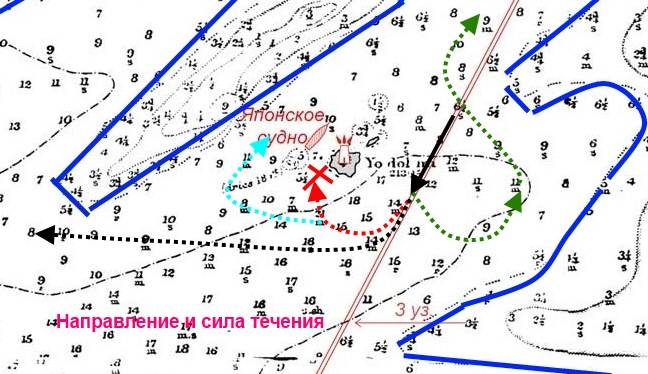
If we accept as a hypothesis that the “Varyag” was not going to turn around, but had to go west along the island, then we will see that the direction of the flow almost coincides with the direction of its movement - that is, the cruiser received an additional 3 course nodes due to , which would at the same time a little more to demolish it from about. Phalmido (Yodolmi). But if he was going to turn around ...
I must say that a ship with a somehow sharp circulation always loses speed - this is a natural physical process. In addition, when turning to Chemulpo, the current that had previously pushed the ship forward and added speed to it, now, on the contrary, would have prevented its movement towards the raid. In general, turn right on 180 degrees at about. Phalmido (Yodolmi) would only lead to the fact that the cruiser almost lost speed, moving barely on 1-2 nodes, while a strong three-node current would blow it to the stones of the island. That is, turning to the right, simply speaking, did not lead to an early return to the raid, but to the creation of a full-fledged emergency situation, it would be quite difficult to get out of it. And this is not to mention the fact that the ship, which almost lost speed, became an excellent target for the Japanese artillerymen.
True, there is another option - to the west of about. Yodolmi train seems to show the presence of a narrow passage, theoretically allowing you to bypass the island from the north and return to the raid. But in fact, this is a completely unrealistic opportunity, because the passage is too narrow, and to stick at it with a strong sidestream, and even almost losing speed, this is a form of suicide. Moreover, everyone knew about the presence of pitfalls in Fr. Phalmido, and there was no guarantee that they on this narrow strip will not. The accident of the Japanese ship (marked on the diagram) perfectly illustrates where such optimism could lead. And, strictly speaking, Varyag made no attempt to circumvent the island in this way (shown on the diagram as turquoise).
Thus, if VF Rudnev was going to interrupt the battle and return to the raid, the cruiser Varyag, of course, turned, but not to the right, but to the left, just where the Koreets would turn a little later (marked with a green arrow in the diagram). Such a turn did not create any navigational problems, because in this case the current would take down the cruiser from the shallows restricting the fairway from the east, but to Fr. Yodolmi at the same time would be enough space. And in general, if we are going to get out of the battle, it would be more logical to turn away from the enemy (turn left), but not at all to the enemy (turn right) right?
But the turn to the right practically deprived Varyag of the possibility of a normal return to Chemulpo’s raid. Turning in this direction, the cruiser could only follow the direction of the Western Canal (the black arrow in the diagram) and approach the Japanese cruisers, who, of course, would intercept it (and the Asama was already on). Attempting to turn "over the right shoulder" so as to return to the fairway leading to the raid automatically led to an emergency, which VF Rudnev, naturally, by all means should have avoided.
As a matter of fact, it is the turn of “Varyag” to the right that the author of this article considers the main evidence that “Varyag” was actually going to fight, and not to imitate a fight.
But what happened next? We read the logbook "Variaga":
There are no doubts that at least two Japanese shells hit the Varyag at that time. Recall that the Japanese recorded an 152-mm projectile hit from the Naniwa into the central part of the cruiser, but in addition, an 12.41-mm projectile between the front bridge and the first chimney was observed on the Asam on 203. After the Varyag was raised in the deck, a large 3,96 hole of the 1,21 meter and ten small holes near it were found near this bridge. At the same time, the 152-mm projectile near the gun in front of the nasal bridge was observed on Takachiho, and on the Asam 3 or 4, projectiles of the same caliber hit the middle of the body (this is doubtful, since no corresponding damage was detected, but on the other hand, there could be a hit in the mast).
And so ... as we said in the last article, there is a suspicion (but not confidence!) That the steering, in fact, did not fail, and this fact is only VF’s fantasy. Rudneva. Consider both versions: №1 "Conspiracy", according to which the steering remained intact, and №2 "Official" - that the steering column was still damaged.
"Conspiracy" - everything is very simple here. Around 12.38, Vsevolod Fedorovich decided to turn right to go to the Western Channel. At Varyag, they raised the signal “P” (turn to the right) and, turning the steering wheel to the appropriate position, proceeded to turn. However, after the start of the turn, the cruiser commander was wounded by fragments of a projectile around 12.40 and the helmsman was seriously wounded. As a result, the control of the cruiser was briefly lost, and the ship, instead of turning around 90 degrees, to go along about. Phalmido (Yodolmi) turns almost to 180 degrees, that is, directly to the island.
The commander comes to himself, but what can he do here now? The situation is exactly as we described it before: “Varyag” goes to the island, having the slightest turn, and the current pulls it down to the stones. Obviously, Vsevolod Fedorovich begins to take vigorous measures to save the ship. What was done exactly, we, alas, is unlikely to ever know.
The commanders of "Niitaki" and "Nanivy" in their "Battle Reports" noted that "Varyag" had taken refuge in Fr. Phalmido (Yodolmi) in 12.54-12.55. This does not contradict Russian sources, and taking into account the fact that the hit, which caused a temporary paralysis of control of the cruiser, happened in 12.40-12.41, from the moment of entry to the care of Fr. Phalmido (Yodolmi) took less than 15 minutes. Most likely, the cruiser during this time really had to back up, and then, moving a long distance from the island, move forward again.
It is possible that when approaching the island, Varyag touched the stones, but perhaps this did not happen. In fact, only one thing is reliably known - somewhere in the interval from 12.40 to 12.55, the cruiser received a fatal hole in the port side, at the waterline level, with an area of about 2 square. m and its lower edge was at 80 cm below the waterline. It cannot be ruled out that this hit was seen on the Naniwa as an 152-mm projectile hit the middle part of the hull on the 12.40, or several hits there, seen on the 12.41 Asam, but most likely it happened later when the cruiser at the very least, he tried somehow to maneuver in Fr. Phalmido (Yodolmi).
Having studied the Varyag and Korey logbooks, as well as other documents, the author suggests the most likely such reconstruction:
12.38-1240 - somewhere in this gap "Varyag" starts turning right, to the west;
12.40-12.41 - hitting an 203-mm projectile causes the ship to lose control of the ship;
12.42-12.44 - somewhere around this time VF Rudnev comes to his senses, control of the cruiser has been restored, but he is being dragged onto the rocks by Fr. Phalmido (Yodolmi ”) and Vsevolod Fedorovich order“ Full back ”. Naturally, it is impossible to execute his command at once — the cruiser steam engines, this is not the engine of a modern car;
12.45 - "Varyag" gets another serious hit 203-mm projectile in the stern, directly behind the fodder 152-mm guns, while a strong fire begins. From the “Combat Report” of the commander of “Asama”: “12.45 8-dm shell hit the deck behind the stern bridge. There was a strong fire, the foregast mast hanging over the starboard. ” At about the same time (plus or minus five minutes) the Varyag gets a hole in the side at the waterline level, and its stoker starts to fill with water;
The 12.45-12.50 Cruiser moves away from the island a sufficient distance in order to give progress. V.F. Rudnev decides to leave the battlefield to assess the damage;
12.50-12.55 - "Varyag" starts moving forward and hides behind Fr. Phalmido (Yodolmi) than for some time prevents the firing at him.
After that, the cruiser retreats to the anchorage (but we'll return to this).
It would seem, so what in all this is so reprehensible? Yes, a tragic accident, with the loss of control, but the cruiser still managed to get out, and that received severe damage, precluding a breakthrough - well, so the ship was in battle, not for a walk. However ... let's look at all this from a different angle. After all, someone could describe the actions of Russian sailors, for example, like this:
And in fact, in a sense, it was true, because the turn of the "Varyag" to Fr. Phalmido really created an emergency situation, as a result of which the cruiser either touched stones or not, but, most certainly, lost speed and had to back up directly in front of the approaching enemy. And it was precisely at this time that the Varyag received a hole in the board of two square meters, which caused the flooding of the stoker and roll in 10 degrees to the port side. To continue the fight in this condition, the ship, of course, could not.
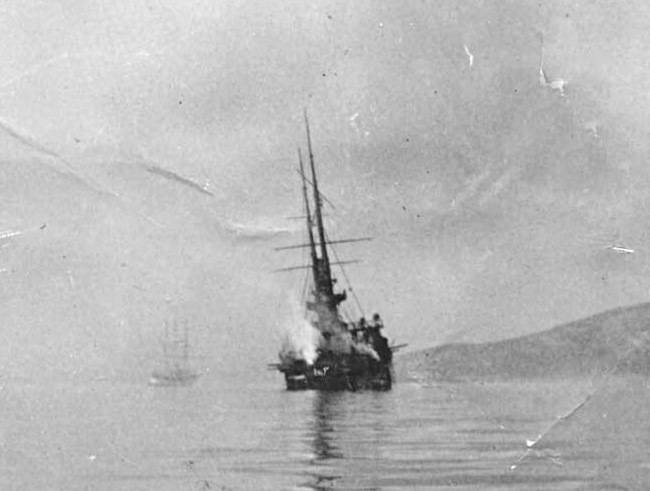
Of course, Vsevolod Fyodorovich was wounded, so it was quite excusable for him to lose control of the situation for a while - and there was not much time to turn to Father Phalmido. The helmsman was also wounded, and if not, it would not be his business to independently change the ship’s course. But, first, all the same, the wound of V.F. Rudneva was not serious, and secondly, the senior navigator officer of the “Varyag” E.M. Berens - and now he should not have allowed the ship to turn on the stones.
Strictly judge Evgeny Mikhailovich is quite difficult. He had just been busy laying a course on the Chemulpo fairway, which was very difficult in terms of navigation, and suddenly there was a shell hit, a commander’s injury, the death of sailors, etc. Who knows what he was doing at that moment, perhaps he rushed to the aid of VF Rudnev, but what he had to do was to make sure that the cruiser did not turn on the stones, he did not. And Vsevolod Fedorovich, nevertheless, “the first after God,” and he was responsible for everything that happens on the ship.
The author of this article does not claim at all that V.F. Rudnev really lied in the report regarding the damaged steering. But, arguing in the framework of "conspiracy" theory, he had a reason for this, because damage to the rudder as a result of the enemy projectile that hit the ship obviously removed the responsibility for creating an emergency situation (turning the Varyag to Phalmido).
That's the whole "conspiracy" version: what about the "official" version, it’s all the same ... except for the fact that the Varyag steering column was really damaged and that the turnaround to Fr. Phalmido could not have been prevented by either the commander or the senior navigator officer of the cruiser.
Thus, we arrive at the following conclusions:
1. Having traversed about. Phalmido (Yodolmi) and turning to the right, “Varyag” did not have the opportunity to turn around to go to the Chemulpo raid - given its low speed and current, the attempt of such a turn automatically led to an emergency situation in which the cruiser almost completely lost speed and with a high proportion Probably sat on the rocks at Yodolmi. It is obvious that Vsevolod Fedorovich could not understand this.
2. A turn to the right (without a turn) led the Varyag and the next Koreets to the course towards the Western Canal and to approach the ships of the Japanese squadron.
3. Had vf Rudnev would like to get out of the fight, he had to turn left - moving in this way, he could return to the fairway without creating an emergency.
4. In view of the above, it can be argued that the very fact of the Varyag turning to the west (right) after leaving the Chemulpo channel leads to the wish of V.F. Rudnev to conduct a decisive battle with the enemy squadron.
5. Also, taking into account the above, with the highest probability of a turn to o. Phalmido was not a result of a deliberate decision, but occurred either as a result of damage to the steering column, or as a result of a short-term loss of control of the ship due to injury of its commander and non-fulfillment of his duties as a senior navigator officer EM. Berens (perhaps both are true at the same time).
6. As a result, turn to o. Phalmido (Yodolmi) and the related loss of speed "Varyag" received critical damage.
7. Reasoning in the framework of "conspiracy" theory, admitting a conscious lie of V.F. Rudnev in the reports he wrote, we conclude that if Vsevolod Fyodorovich lied, then the meaning of his lie was not to hide his unwillingness to fight, but to “retouch” the unfortunate turn in about. Phalmido and the Varyag critical damage associated with it.
Apparently, Vsevolod Fedorovich was just unlucky (or, conversely, lucky, here's how to look). With the highest probability, if it were not for the Japanese projectile, which hit the cruiser on 12.41 and temporarily unsettled VF Rudnev (and also, possibly, damaged the steering column of the ship), then we would read in the sources about the cruiser and the gunboat, who took their last battle in the reach behind the channel of Chemulpo and heroically died in an unequal battle on the way to the Western Channel. However, the short-term "failure" V.F. Rudneva in combination with the erroneous actions of EM. Behrens or damage to the steering column led to the fact that the cruiser almost sat on the stones and received damage, making the continuation of the breakthrough completely inappropriate.
In the discussions of this series of articles, much has been said about the “agreement” between V.F. Rudnev and officers of the cruiser and the gunboat. They say that the logbooks were filled up after the battle, so that the gentlemen could agree among themselves on what exactly to write there. In the next article we will try to assess the likelihood of such a development based on the battle descriptions given in the logbooks of both Russian ships.
Продолжение следует ...
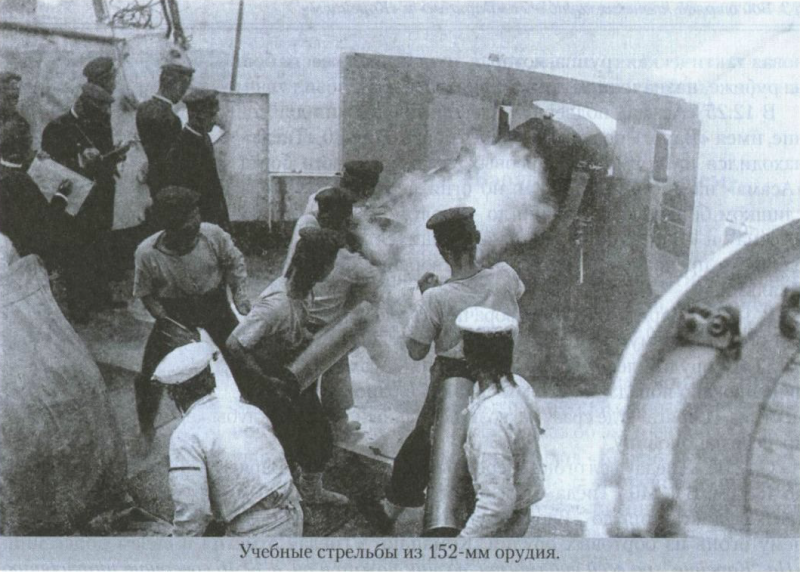
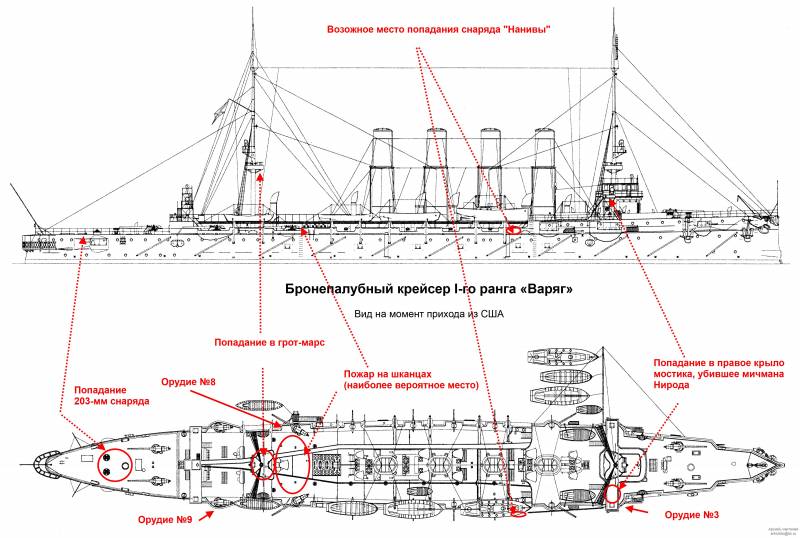
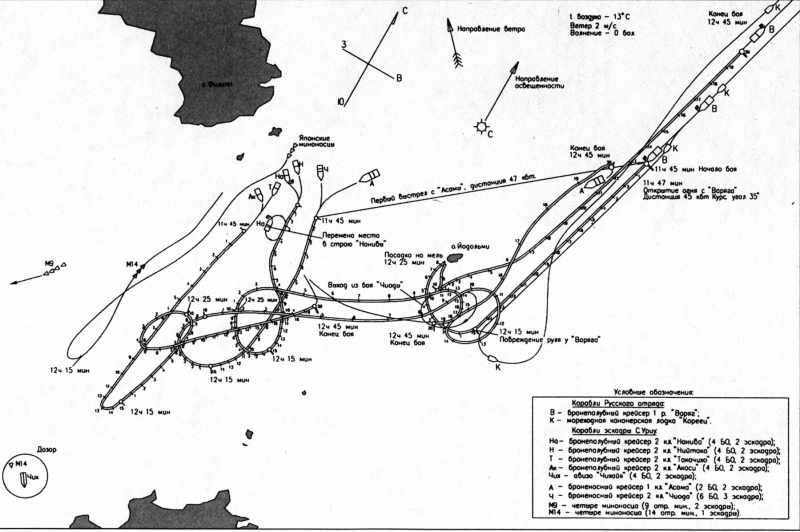
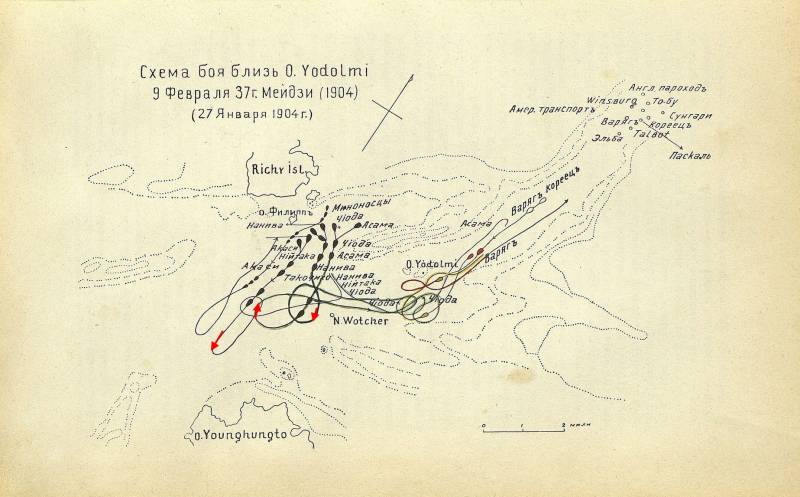
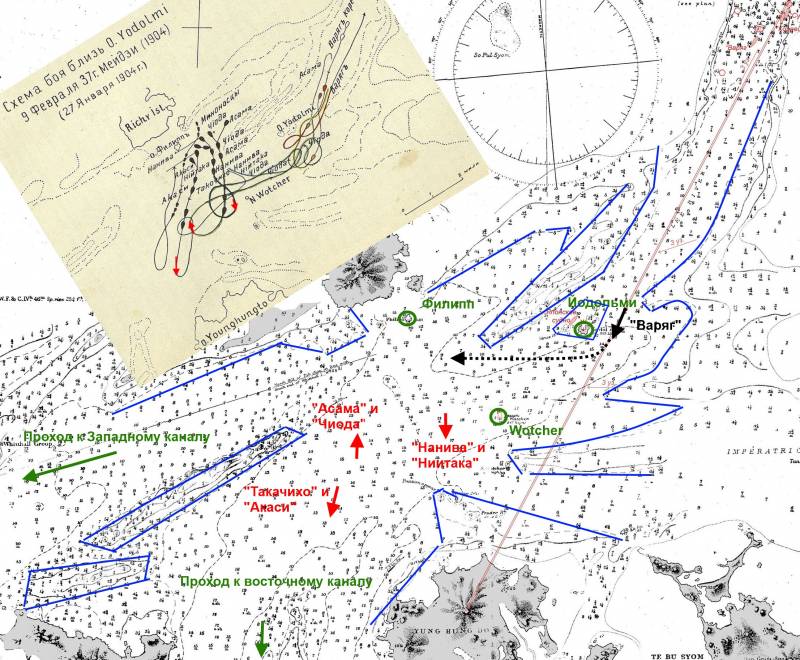
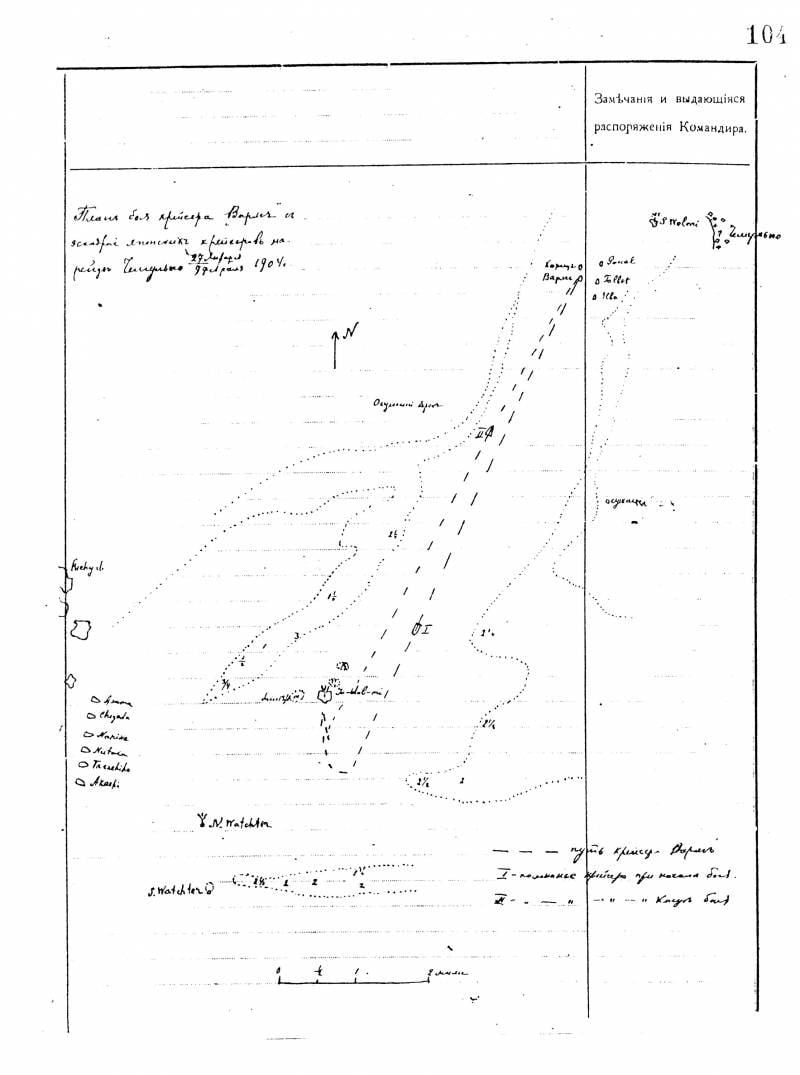
Information